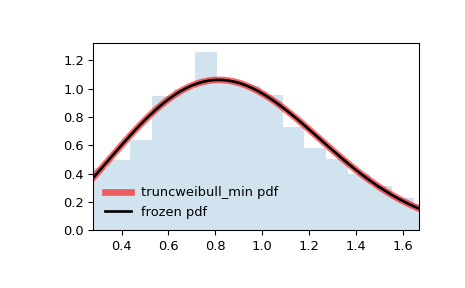scipy.stats.truncweibull_min#
- scipy.stats.truncweibull_min = <scipy.stats._continuous_distns.truncweibull_min_gen object>[source]#
A doubly truncated Weibull minimum continuous random variable.
As an instance of the
rv_continuousclass,truncweibull_minobject inherits from it a collection of generic methods (see below for the full list), and completes them with details specific for this particular distribution.Methods
rvs(c, a, b, loc=0, scale=1, size=1, random_state=None)
Random variates.
pdf(x, c, a, b, loc=0, scale=1)
Probability density function.
logpdf(x, c, a, b, loc=0, scale=1)
Log of the probability density function.
cdf(x, c, a, b, loc=0, scale=1)
Cumulative distribution function.
logcdf(x, c, a, b, loc=0, scale=1)
Log of the cumulative distribution function.
sf(x, c, a, b, loc=0, scale=1)
Survival function (also defined as
1 - cdf, but sf is sometimes more accurate).logsf(x, c, a, b, loc=0, scale=1)
Log of the survival function.
ppf(q, c, a, b, loc=0, scale=1)
Percent point function (inverse of
cdf— percentiles).isf(q, c, a, b, loc=0, scale=1)
Inverse survival function (inverse of
sf).moment(order, c, a, b, loc=0, scale=1)
Non-central moment of the specified order.
stats(c, a, b, loc=0, scale=1, moments=’mv’)
Mean(‘m’), variance(‘v’), skew(‘s’), and/or kurtosis(‘k’).
entropy(c, a, b, loc=0, scale=1)
(Differential) entropy of the RV.
fit(data)
Parameter estimates for generic data. See scipy.stats.rv_continuous.fit for detailed documentation of the keyword arguments.
expect(func, args=(c, a, b), loc=0, scale=1, lb=None, ub=None, conditional=False, **kwds)
Expected value of a function (of one argument) with respect to the distribution.
median(c, a, b, loc=0, scale=1)
Median of the distribution.
mean(c, a, b, loc=0, scale=1)
Mean of the distribution.
var(c, a, b, loc=0, scale=1)
Variance of the distribution.
std(c, a, b, loc=0, scale=1)
Standard deviation of the distribution.
interval(confidence, c, a, b, loc=0, scale=1)
Confidence interval with equal areas around the median.
See also
Notes
The probability density function for
truncweibull_minis:\[f(x, a, b, c) = \frac{c x^{c-1} \exp(-x^c)}{\exp(-a^c) - \exp(-b^c)}\]for \(a < x <= b\), \(0 \le a < b\) and \(c > 0\).
truncweibull_mintakes \(a\), \(b\), and \(c\) as shape parameters.Notice that the truncation values, \(a\) and \(b\), are defined in standardized form:
\[a = (u_l - loc)/scale b = (u_r - loc)/scale\]where \(u_l\) and \(u_r\) are the specific left and right truncation values, respectively. In other words, the support of the distribution becomes \((a*scale + loc) < x <= (b*scale + loc)\) when \(loc\) and/or \(scale\) are provided.
The probability density above is defined in the “standardized” form. To shift and/or scale the distribution use the
locandscaleparameters. Specifically,truncweibull_min.pdf(x, c, a, b, loc, scale)is identically equivalent totruncweibull_min.pdf(y, c, a, b) / scalewithy = (x - loc) / scale. Note that shifting the location of a distribution does not make it a “noncentral” distribution; noncentral generalizations of some distributions are available in separate classes.References
[1]Rinne, H. “The Weibull Distribution: A Handbook”. CRC Press (2009).
Examples
>>> import numpy as np >>> from scipy.stats import truncweibull_min >>> import matplotlib.pyplot as plt >>> fig, ax = plt.subplots(1, 1)
Get the support:
>>> c, a, b = 2.5, 0.25, 1.75 >>> lb, ub = truncweibull_min.support(c, a, b)
Calculate the first four moments:
>>> mean, var, skew, kurt = truncweibull_min.stats(c, a, b, moments='mvsk')
Display the probability density function (
pdf):>>> x = np.linspace(truncweibull_min.ppf(0.01, c, a, b), ... truncweibull_min.ppf(0.99, c, a, b), 100) >>> ax.plot(x, truncweibull_min.pdf(x, c, a, b), ... 'r-', lw=5, alpha=0.6, label='truncweibull_min pdf')
Alternatively, the distribution object can be called (as a function) to fix the shape, location and scale parameters. This returns a “frozen” RV object holding the given parameters fixed.
Freeze the distribution and display the frozen
pdf:>>> rv = truncweibull_min(c, a, b) >>> ax.plot(x, rv.pdf(x), 'k-', lw=2, label='frozen pdf')
Check accuracy of
cdfandppf:>>> vals = truncweibull_min.ppf([0.001, 0.5, 0.999], c, a, b) >>> np.allclose([0.001, 0.5, 0.999], truncweibull_min.cdf(vals, c, a, b)) True
Generate random numbers:
>>> r = truncweibull_min.rvs(c, a, b, size=1000)
And compare the histogram:
>>> ax.hist(r, density=True, bins='auto', histtype='stepfilled', alpha=0.2) >>> ax.set_xlim([x[0], x[-1]]) >>> ax.legend(loc='best', frameon=False) >>> plt.show()
